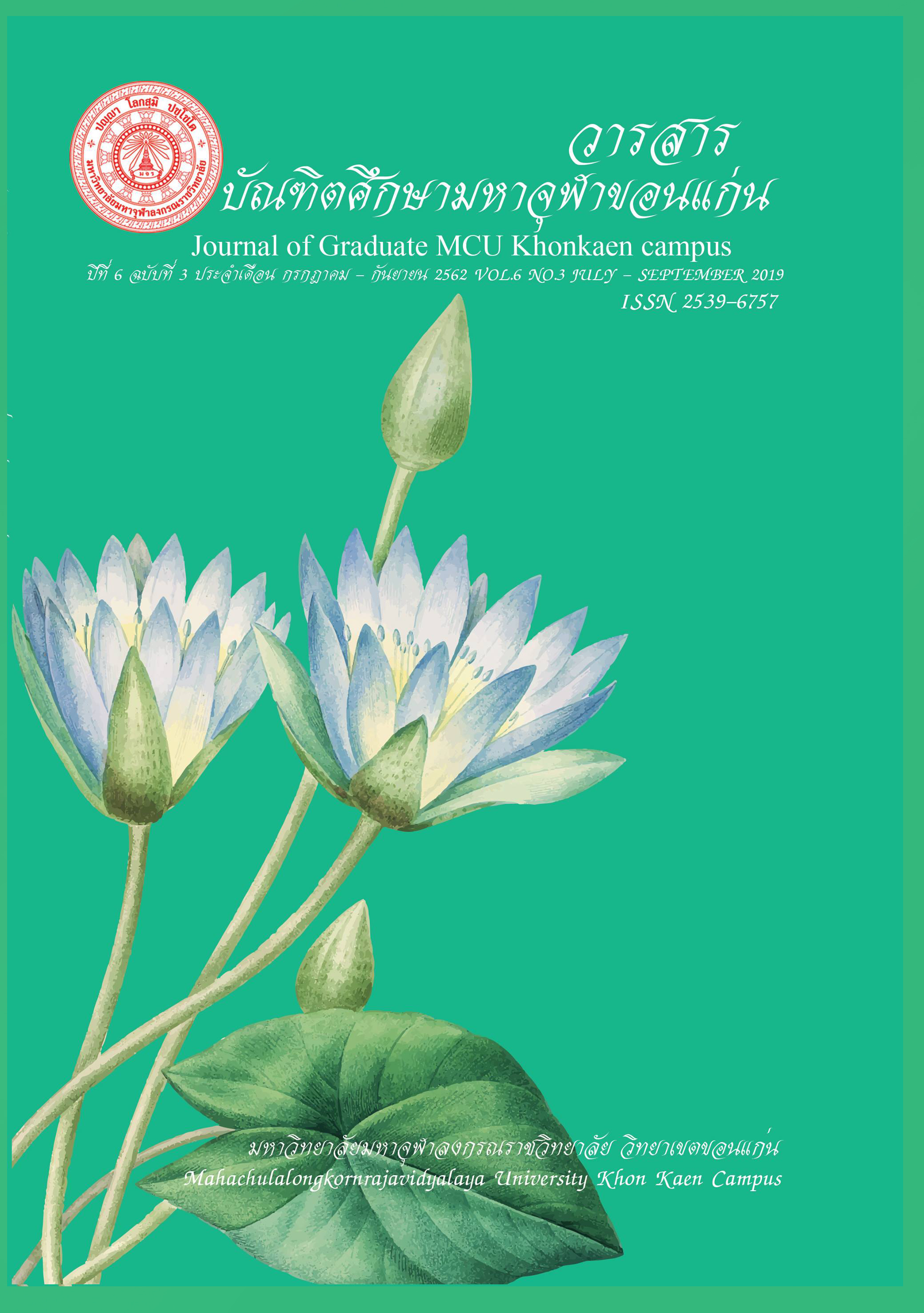Integration of Buddhist principles for development of the working life quality of officer in Department of Disaster Prevention and Mitigation, Ministry of Interior
Main Article Content
Abstract
The objectives of this research were 1) to study factors affecting the development of the working life quality of officer in Department of Disaster Prevention and Mitigation, Ministry of Interior 2) to verify the integration model of Buddhist principles with the development of working life quality of officer in Department of Disaster Prevention and Mitigation, Ministry of Interior and 3) to propose the integration of Buddhist principles for development of the working life quality of officer in Department of Disaster Prevention and Mitigation, Ministry of Interior.
Methodology was the mixed methods research between the qualitative research and quantitative research, the process was divided two steps, step 1 is quantitative research in survey for validity checking of the model in Integration of Buddhist principles for development the work life quality well, studying the direct effect and indirect effect between the variable model by collecting data from 470 samples. The statistics used the analyze descriptive data by frequency, mean, standard deviation (S.D.), Skewness, Kurtosis, Exploratory Factor Analysis (EFA), Reliability, Confirmatory Factor Analysis (CFA), and Linear Structural Relationship (LISREL). And step 2 is qualitative research by In-dept interview from keys informant 17 persons, to confirm after analyzing data.
The findings of the research were as follows: 1. The level in working life quality of officer in Department of Disaster Prevention and Mitigation respectively, the first one is job description for social benefits, secondly, development of a person's ability, thirdly, organizational democracy, fourth, sustainability and work progress, fifth, social integration, sixth, balancing between working and daily life, and the last one, seven, safety in working, nine, compensation adequate and fairly.
- 2. The validity of model of integration of Buddhist principles for development of the working life quality of officer in Department of Disaster Prevention and Mitigation, Ministry of Interior was found that p-value with significantly statistics at the level of 0.081, Chi-Square ( ) = 93.79, Degree of freedom (df) = 76, Chi-Square ( ) = 1.23, Goodness of Fit Index (GFI) = 0.98, AGFI = 0.95, CFI = 1.00, SRMR = 0.031, RMSEA = 0.022, and CN = 527.81. The result showed that the statistics of coherence of model has conformed to the empirical data.
- 3. The factors affecting for development the working life quality of officer in Department of Disaster Prevention and Mitigation, Ministry of Interior, found that the variable validity between 0.50 - 0.92, by the variable had high validity that is JITTA PAVANA = 0.92, then SILA PAVANA = 0.79, the variable validity had lowest value that is social responsibility, and compensation adequate and fairly = 0.52 Adjusted R2= 0.79 showed that the variable of model was explained the variability of work life quality = 79 %, considered the direct effect and indirect effect to variable of work life quality found that the variable was taken from direct effect on environment and task = 0.85. After that the variable was divided as social support = 87 %, Corporate atmosphere = 82 %, satisfaction in working = 80 %, creation in culture = 75 %, participatory culture = 75 %, and social responsibility = 72 % respectively. Moreover, PAVANA also has taken from direct effect on environment and task = 0.44 that the effect to significantly statistics at the level of 0.01.
Article Details
References
JedsadaWittayasomboon. (2013). “Quality of BureaucratWork Life: Case study fireman fire and rescue department 1 Department of Disaster Prevention and Mitigation.Ministry of Interior Bangkok”.Thesis of Public Administration.Bangkok: Graduate School Siam University.
Personnel Division of Department of Disaster Prevention and Mitigation.(2018).Ministry of Interior.personnel data of Department of Disaster Prevention and Mitigation. [Online: http://122.155.1.141/inner.personnel-4.183/download/menu_3967/. [June 202018].
PornsakPoungpeaw.(1986).Research Sciences.Bangkok: thaiwatanapanich press co. ltd.
SuphangChanwanich.(2010).Qualitative data analysis.Bangkok: Chulalongkorn University press.
Lofland.J. (1984).Analyzing Social Settings.Blemont: Calif.Wadworth.
Channarong In-Iw.(2013).“A Model of Development of Quality of Work Life of Teachers in Basic Education Schools”.Journal of Education Naresuan University.Vol15 official.
Sukunthamagnawthong (Flying Officer).(2015). Causal factors affecting the quality of work life of nursing officers at BhumibolAdulyadej Hospital ".National Academic Conference Business Administration and Accounting Division 2.Kasetsart University.
PiyapornWongaudom.(2016).“The causal model of factors affecting teachers’ happiness at workplace in rural primary schools in the upper north region of Thailand the office of basic education commission”.ValayaAlongkorn Review. Vol.6. No.3 (September – December 2016).
ThanidaTipwatee.(2017). “work factors to work-life balance of registered nursesat least 1years’ experience in patient care units at BhumibolAdulyadej Hospital”. The Journal of The Royal Thai Army Nurses. Vol.18. Official (January – April 2017).
Somkiattiyotworadet&Poonyaphatchaimay.(2015). “Factors associated with quality of working life among health personnel in Kong-Ra Hospital.Phatthalung Province.”.Journal of Health Science. Vol.24. No.2 (March-April 2015).
VipanunPavapatta&SuwannaNarkwiboonwong.(2015).“A Causal Relationship Model Development of Organizational Commitment of Thai Airways Technical Department”.Kasetsart J. (Soc. Sci).
Penny Phumitharanon.(2012). “Confirmatory Factor Analysis Model of Corporate Social Responsibility: Labor Practices”.Suthiparithat Journal Vol.25 No.76 (2012).

